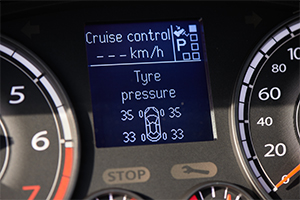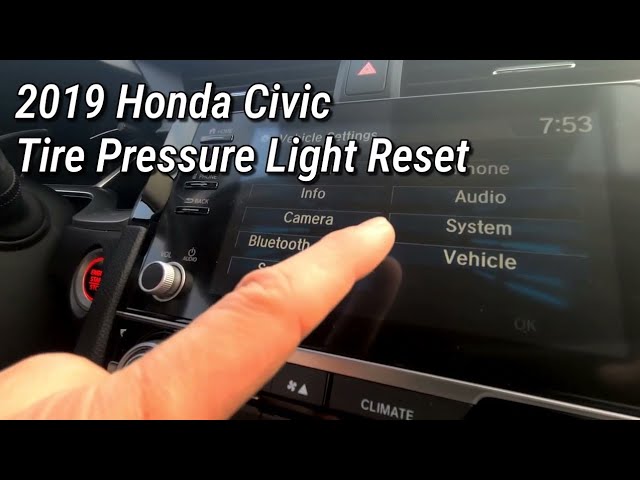As an Amazon Associate, I earn from qualifying purchases
Keeping your Honda Civic 2019’s tires at the right pressure is easier than you might think—and it can save you money, improve safety, and boost fuel efficiency. But how do you quickly check your tire pressure without any hassle?
If you want a simple, step-by-step guide that anyone can follow, you’re in the right place. By the end of this article, you’ll know exactly how to keep your tires in top shape, so your car runs smoothly and you stay safe on the road.
Let’s get started!

Credit: www.reddit.com
Tools Needed For Tire Pressure Check
Checking tire pressure on your 2019 Honda Civic is easy with the right tools. Proper tools help you get accurate readings. This ensures your tires perform well and last longer. Keep these tools handy for quick checks anytime.
Choosing A Reliable Tire Pressure Gauge
A good tire pressure gauge is small and simple to use. Analog and digital gauges both work well. Digital gauges show numbers clearly and are easy to read. Analog gauges are sturdy and don’t need batteries. Make sure the gauge measures in PSI, the unit used for Honda Civic tires. Check the gauge for accuracy before use. A reliable gauge gives fast and precise readings every time.
Optional: Using A Tire Pressure Monitoring System
Your 2019 Honda Civic may have a Tire Pressure Monitoring System (TPMS). This system warns you if tire pressure is too low. TPMS sensors are inside each tire and send signals to your dashboard. This makes checking easier and safer. Still, use a gauge for the best accuracy. TPMS works well as a backup, but it does not replace manual checks.
Locate The Valve Stem
Locating the valve stem is the first step to check tire pressure on a 2019 Honda Civic. The valve stem is a small, tube-like part on your tire. It allows air to enter or leave the tire. Knowing where it is helps you measure and adjust the tire pressure easily. This section explains how to find and prepare the valve stem for pressure checking.
Finding Valve Stems On Honda Civic Tires
Each tire on your Honda Civic has one valve stem. It sticks out from the wheel rim. Look closely near the edge of the tire. The valve stem looks like a small rubber or metal tube. It usually has a cap on it. The cap keeps dirt and dust out. Sometimes it can be hard to spot if the tire is dirty. Clean the wheel edge if needed to see it clearly.
Preparing The Valve Stem For Measurement
Before checking pressure, remove the valve cap carefully. Turn it counterclockwise. Put the cap in a safe place. Avoid losing it. Check the valve stem for dirt or damage. Wipe it clean with a cloth. This helps get an accurate reading. Press the tire pressure gauge firmly onto the valve stem. Hold it steady until you get the pressure number. Replace the valve cap tightly after checking.
Find Recommended Tire Pressure
Finding the right tire pressure for your 2019 Honda Civic is important. Proper pressure keeps your tires safe and helps your car run smoothly. Too much or too little air can cause problems. The best place to find the correct tire pressure is from your car itself. Here are two easy ways to check.
Checking The Honda Civic Door Sticker
Open the driver’s side door. Look on the edge or the door frame. You will see a white sticker with tire details. This sticker shows the exact tire pressure for front and rear tires. It lists the pressure in PSI (pounds per square inch). Follow these numbers for the best results. This sticker is easy to find and always accurate.
Consulting The Owner’s Manual
Use the owner’s manual that came with your Civic. Find the section about tires or maintenance. The manual gives detailed information on tire pressure. It also explains why correct pressure matters. Keep the manual in your glove box for quick access. It is a reliable source if you cannot find the door sticker.

Credit: www.earnhardthonda.com
Step-by-step Tire Pressure Check
Checking tire pressure on your 2019 Honda Civic is simple. Proper tire pressure improves safety and fuel efficiency. Follow these easy steps to check your tire pressure correctly.
Removing The Valve Cap
Locate the valve stem on your tire. It is a small rubber or metal nozzle. Unscrew the valve cap by turning it counterclockwise. Keep the cap in a safe place. This prevents dirt from entering the valve.
Using The Tire Pressure Gauge Correctly
Press the tire pressure gauge firmly onto the valve stem. Ensure no air hisses out. Hold it steady for a few seconds. Remove the gauge carefully to get an accurate reading.
Reading And Interpreting The Gauge
Look at the gauge’s display or stick. Check the number showing the pressure in PSI (pounds per square inch). Compare this number to the recommended pressure. Find this info on your Civic’s door sticker or manual. Inflate or deflate tires as needed to match the recommended pressure.
Adjusting Tire Pressure
Adjusting tire pressure is important for your Honda Civic 2019. Proper pressure improves fuel efficiency and tire life. It also keeps your car safe on the road.
Check tire pressure regularly. Use a reliable tire pressure gauge to get accurate readings. Adjust the pressure if it is too low or too high.
Adding Air To Underinflated Tires
Locate the valve stem on the tire. Remove the cap and press the air hose nozzle firmly onto it. Add air in short bursts.
Stop and check the pressure often. Avoid overfilling by comparing with the recommended pressure. Replace the valve cap tightly after filling.
Releasing Air From Overinflated Tires
Find the valve stem and remove the cap. Press the small pin inside the valve with a tool or fingernail. Air will start to escape.
Check the pressure frequently. Stop releasing air once it reaches the correct level. Always replace the valve cap securely.
Tips For Accurate Readings
Getting accurate tire pressure readings is key for safe driving and good fuel economy. Simple steps help you avoid mistakes and get exact numbers. Follow these tips to check your Honda Civic 2019 tires correctly every time.
Checking at the right time and keeping a routine helps your tires last longer. It also keeps your car stable on the road.
Checking Pressure When Tires Are Cold
Check tire pressure before driving or after the car sits for at least three hours. Heat from driving makes tires expand and gives wrong readings. Cold tires show the real pressure inside. Use a reliable gauge and press it firmly on the valve stem. Listen for a brief hiss to ensure no air escapes. Record the number quickly to avoid errors.
Regular Tire Pressure Maintenance
Check your tires at least once a month. Also, check before long trips or heavy loads. Keep a small pressure gauge in your glove box for easy checks. Adjust the pressure to the number in your Honda Civic’s manual. Do not guess or use the maximum number on the tire sidewall. Proper care helps prevent tire wear and improves safety.
Benefits Of Proper Tire Pressure
Maintaining the right tire pressure in your 2019 Honda Civic brings many benefits. Proper pressure helps your car run smoothly and saves money. It also keeps you safe on the road. Checking your tire pressure often is a smart habit.
Here are some key advantages of keeping your tire pressure at the correct level.
Improved Fuel Efficiency
Proper tire pressure reduces rolling resistance. Your engine uses less fuel to move the car. This means you spend less money on gas. Tires with low pressure make the engine work harder. Keeping tires at the right pressure helps save fuel every day.
Enhanced Safety And Tire Longevity
Correct tire pressure improves car handling and braking. This reduces the risk of accidents. Tires wear evenly, lasting longer with proper pressure. Under-inflated tires can cause blowouts or uneven wear. Check pressure regularly for safer driving and longer tire life.

Credit: www.youtube.com
Frequently Asked Questions
How Do I Check Tire Pressure On A 2019 Honda Civic?
Use a tire pressure gauge on the valve stem when tires are cold. Compare with recommended PSI.
What Is The Recommended Tire Pressure For Honda Civic 2019?
The recommended tire pressure is usually 32 PSI. Check the sticker inside the driver’s door.
How Often Should I Check My 2019 Honda Civic’s Tire Pressure?
Check tire pressure at least once a month and before long trips for safety and fuel efficiency.
Can I Check Tire Pressure Without A Gauge On Honda Civic?
No, a tire pressure gauge is needed for an accurate reading to maintain proper tire health.
What Happens If Tire Pressure Is Too Low On Honda Civic?
Low pressure can cause poor fuel economy, tire wear, and unsafe driving conditions.
Does Temperature Affect Tire Pressure In A Honda Civic?
Yes, cold weather lowers tire pressure. Check and adjust pressure regularly in changing seasons.
Conclusion
Checking tire pressure on your Honda Civic 2019 is quick and simple. Use a reliable pressure gauge and compare it to the recommended PSI. Keep your tires properly inflated for safety and better fuel efficiency. Regular checks help avoid tire damage and improve driving comfort.
Make tire pressure a part of your routine car care. This small step keeps your Civic running smoothly and safely on the road. Easy to do, important to remember.
As an Amazon Associate, I earn from qualifying purchases


